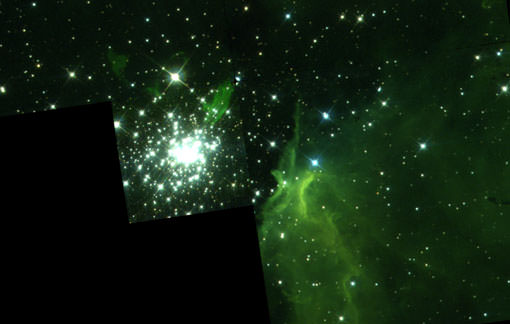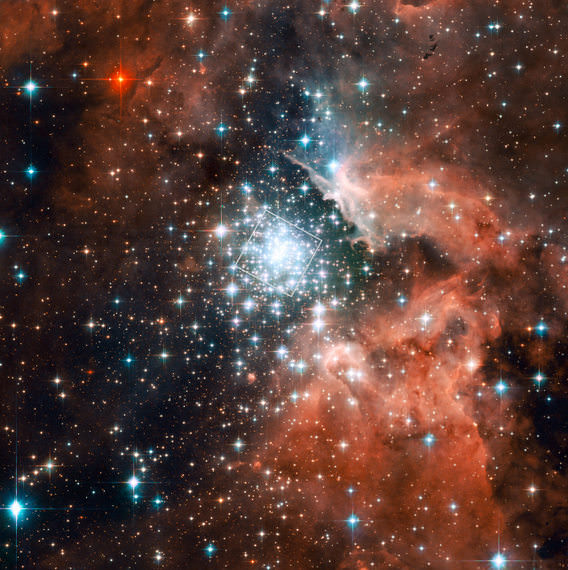[/caption]
Using the Hubble Space Telescope, astronomers from the Max Planck Institute for Astronomy made two observations ten years apart of the giant nebula NGC 3603 and found a surprising amount of movement and unrest in one of the most massive young star clusters in the Milky Way. The comparison images reveal several hundred stars continued to move for about 1 million years after the star cluster’s formation, with stellar motion not having “settled down” as expected. This new finding is at odds with current models of how such clusters evolve, and may force astronomers to rethink how star clusters form and develop.
While ordinary star clusters disperse over time as the different stars go their own separate ways, it was thought that very massive and compact clusters were different, and that they formed massive aggregations of stars known as globular clusters, whose tightly-packed stars remain gravitationally bound to each other for billions of years.
Conventional thinking was that stars with lower mass should move faster, and those with higher mass should move more slowly. But a team led by Wolfgang Brander, making high precision observations, found the stars in NGC 3603 are still moving at rates that are independent of their mass.
They found that all of the stars move at about the same average speed of 4.5 km/s (corresponding to a change in apparent position of a mere 140 micro-arc seconds per year). The average speed does not appear to vary with mass at all.
The team observed more than 800 stars and were able to obtain sufficiently precise speed measurements for 234 cluster stars of different masses and surface temperatures.

“Once our analysis was completed, we reached a precision of 27 millionths of an arc second per year,” said Boyke Rochau, the paper’s lead author. “Imagine you are in Bremen, observing an object that is located in Vienna. Now the object moves sideways by the breadth of a human hair. That’s a change in apparent position of about 27 millionths of an arc second.”
Apparently – and surprisingly – this very massive star cluster has not yet settled down. Instead, the stars’ velocities still reflect conditions from the time the cluster was formed, approximately one million years ago.
“For the first time, we have been able to measure precise stellar motions in such a compact young star cluster. This is key information for astronomers trying to understand how such clusters are formed, and how they evolve,” said team member Andrea Stolte from the University of Cologne.
Vexingly, the question of whether or not the massive young cluster in NGC 3603 will become a globular cluster remains open. Given the new results, it all depends on the speeds of the low-mass stars, which were too faint to allow for precise speed measurements with the Hubble Space Telescope. “To find out whether or not our star cluster will disperse, we will need to wait for the next generation of telescopes, such as the James Webb Space Telescope (JWST) or ESO’s European Extremely Large Telescope (E-ELT),” said Brandner.
The results have been published in the Letters section of the Astrophysical Journal. Read the paper here.
Sources: Max Planck Institute for Astronomy, Hubble ESA


Far out.
Speaking of far out speculation it sounds from the sketch of the findings like someone found a massive hunk of DM? (Superficially it sounds similar to galaxy rotation results to me.) Though gravitational lensing should have ruled it out, I guess. Ah, well.
Nancy
This article is frustrating because you don’t say where it is in the sky!!!
NGC 3603 is in the southern constellation of Carina located at Right Ascension 11h 15.3m Declination ?61 deg 16′. It lies 8.5 deg west of the first magnitude star Acrux in the constellation of . Crux. This rich open cluster is a familiar open cluster to southern observers.
Why do you just simply say this?
If you want others to be interested in your articles, placing the object in question to us telescopists would be ideal without having to chase the information.
Other than that, an excellent article (as per usual!)
I am an amateur astronomer and Globular and Star Clusters are some of my favorite viewing objects. During summer star parties they are the most often asked for and viewed – next to the brighter Galaxies, occasional Comet, Planets and Planetary Nebula. SOME DAY, I’ll make my way down to the Southern Hemisphere and finally see the wonders there… I’ll make a note to include NGC 3603!
I am at 38D 31′ N.. but have seen Omega Centauri several times from the coastal mountains nearby as we are west of the lights of San Francisco. My all time favorite!
“Apparently – and surprisingly – this very massive star cluster has not yet settled down.”
The paper notes that given its age, the fact that the cluster is not in virial equilibrium is not entirely unexpected. This finding could have consequences regarding the mass of extragalactic starburst clusters (young, massive ‘blue’ star clusters seen in M 82, the Antennae Galaxy, Fornax A and Andromeda, for example). They note that mass estimates of these star clusters are based on measures of velocity dispersions, and, if not in virial equilibrium, may lead to systematically overestimated masses.
In any case, studies of nearby examples of starburst clusters like NGC 3603 will greatly increase our understanding of their extragalactic brethren.
HSBC- sorry about that; that info is something we normally try to include, but just did not this time. Will redouble our efforts!
D’oh! Yes, that would work for any conservative potential, regardless of matter distributions. Thanks!
I really like the pic. I’m surprised that nobody pointed it out.